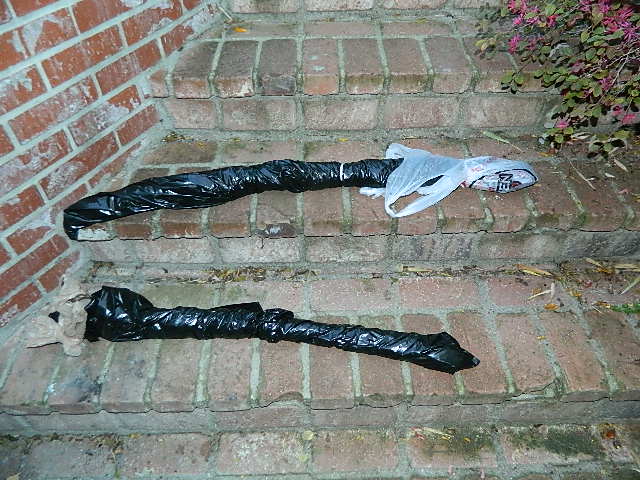Those exposed to the deepest cold, callused the fastest and best. Those from more moderate weather situations developed less callus. Also interestingly, when the outdoor temperatures were in the sixties and seventies, the results were less dramatic. When we experienced the week of eighties and near ninety degree temperatures, the cuttings callused heavily and quite quickly. I removed a batch after ten days which had callused quite heavily.
I wouldn't have expected the outdoor temperature to have had such a dramatic effect on wraps held inside the house with the thermostat set at a continuous 68 degrees F, but it did!
These cuttings are from two varieties, both of which I intend to use to bud standards, or tree roses. The first is a seedling I raised a number of years ago from a cross I knew had to result in something neat. I used Ralph Moore's yellow climbing miniature breeder, 1-72-1 as the seed parent with pollen from Tom Carruth's wonderful shrub, Midnight Blue expecting something hopefully without prickles (or very few) and with strong coloring. I raised a very vigorous climber with lovely foliage and very few prickles...and absolute no flowers in over eight years. So, I decided to try it as a root stock to see how it might work. The wood is very strong, and as you can see from the photos, it calluses extremely well!
These are the two wraps with the long whips in them.
This is the 1-72-1 X Midnight Blue material after two weeks in the house. Notice how it has also callused from the wounds where I disbudded it to prevent suckers.
A few had already begun throwing small roots from the calluses.
Close up of the callused ends.
The other variety I am using for standard trunks, I've used before with very good results. I have a standard of Baby Faurax which I budded on Cardinal Hume in 1994 and it's still going strong. These are shorter pieces of Cardinal Hume I will use to bud bushes with.
The two longer whips also callused very well.
Even from the disbudding wounds, like the seedling did. The purple coloring to the canes isn't disease, but the coloring this variety normally develops in my garden at this time of year.
The callus isn't discolored due to rot, but discolored because it had adhered to the newspaper and absorbed inks from it.
The longer whips are all wrapped in white plastic trash bag strips and potted to continue rooting. To review how to wrap longer cuttings in white plastic to prevent them from drying out while rooting, please see the previous entry here about rooting longer cuttings.
I plan on using these to bud the shorter polyanthas out back, in hopes of protecting them from being mowed down by the rabbits who refuse to leave them alone. There are also two smaller ground cover varieties I wish to use for breeding which don't lend themselves easily to my space grown on the ground. Hopefully, by creating shorter weeping standards of them, I will be able to grow and use them more easily. I'm keeping my fingers crossed!









No comments:
Post a Comment